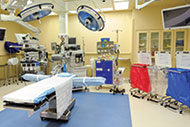 |
|
A bathroom pod being installed on-site during a hospital expansion. Photos courtesy of Skanska USA |
Prefabrication and modularization bring many of the same advantages to health care planning, design and construction projects.
Both methods help to maximize return on investment for health care organizations' performing new construction or renovation projects by reducing waste and improving speed of construction.
Both also are well-suited for creating the complex, yet repetitive, components that populate health care facilities, such as vertical and horizontal mechanical-electrical-plumbing (MEP) systems, patient rooms, bathrooms, clinical spaces and envelope systems.
Additionally, both methods rely on sophisticated 3-D building information modeling (BIM), which encourages consistency and collaboration among all project team members.
However, the two methods also have significant differences, and knowing about them will help health facilities professionals to select the most appropriate one for their particular project.
Prefab vs. modularization
Prefabrication is the process of assembling building components, such as bathroom pods, to a complete state and transporting them to the project site for installation.
Prefabrication is more readily used and accepted in the health care industry, especially because it involves building elements that are easy to prefabricate, such as combined-service MEP racks and risers, patient headwalls and footwalls, exterior skins, exterior enclosure systems, electrical rooms and medical gas-zone valve boxes.
The repetitive nature of prefabrication units produces less above-ceiling clutter and provides hospital maintenance staff with a more efficient model for future modifications.
Modularization refers to a finished unit or "mod," such as an entire patient room, that is transported to the construction site ready for assembly in a specific order to create an end product. The process is similar to putting together a puzzle.
Modularization is newer to the industry than prefabrication. Although the method is beginning to be used on smaller and simpler buildings, such as outpatient treatment centers, modularization also is well-suited for work on multistory patient towers.
According to the Modular Building Institute, the method removes approximately 80 percent of the building construction activity from the site location and significantly reduces site disruption.
Making the decision
The decision to use prefabricated or modular elements in a health care construction project depends on a number of variables. Key among these is the design of the project itself, the parties involved with the project and logistical considerations.
The role of design. To ensure that all elements are suited for constructability and the chosen method of construction before a project gets off the ground, the project's design is tested and analyzed for specific application to either prefabrication or modularization. Prefabrication and modularization should be driven by the design as opposed to the other way around. To confirm that a design will work with either method, health facilities professionals must have a vivid end goal that allows them to commit and communicate up front the design decisions that will guide the 3-D model.
With modularization, the units arrive at the job site from the manufacturer in their completed form. The units have extremely specific constraints on height, width, weight and configuration, which all need to be incorporated into a project's 3-D model from the beginning. Teams collectively discuss and decide on specific details, such as the type of toilets or floor tiles, early in the project's process to establish the project design's workflow. The planning and collaborative decision-making enables the team to vet design decisions working together from the project's onset and, as a result, this integrated process reduces the likelihood of changes on project specifics further into construction.
Prefabrication requires extensive, collaborative up-front planning as well. Ultimately, prefabrication projects incorporate design specifics, such as the number and location of outlets in a given patient room; however, a project team requires less specificity on smaller details to conceptualize and plan for prefabrication. When the project reaches the point at which those details need to be determined, the entire team convenes to make those decisions.
With each method, the team must analyze a project's design to determine workflow. The right method to use depends on the detail available in the earliest part of the project's design versus what might come later. However, the repetitive nature of both construction methods increases speed to market and also can deliver maintenance advantages for a facility's staff once the project is complete.
Owner involvement. Prefabrication and modularization drive transparency between the owner and the entire construction team. For example, at the Nemours/Alfred I. duPont Hospital for Children in Wilmington, Del., team members often visited the facility to observe the prefabrication work, which gave them the opportunity to verify compliance with the contract documents and ensure that quality standards were being met.
For prefabrication, BIM allows the construction team to track a project's process and predict the direct impact of changes during the course of a project. As a result, teams work with the owner to make informed decisions that consistently add value. If an owner decides to change 50 percent of a facility's prefabricated headwalls, the construction team can use BIM to illustrate how that change will affect other elements of the job and its overall schedule.
While performing prefabrication work for the construction of University Medical Center in New Orleans, for instance, a team worked with the owner and designers to make design refinements based on user group needs prior to commencing fabrication. The team detailed out spaces based on the project's design, constructed mock-ups for user groups to view, and incorporated their feedback into the project plan to align with its overall workflow.
At the onset of any project, a team should think deeply about how prefabrication or modularization will bring value to the owner's project, including decreasing the amount of construction noise at the job site as well as a reduced overall impact because much less work is taking place on-site.
Location. The location of a health care facility also can drive the decision on whether to prefabricate or modularize elements of a project. If the project is located in a part of the country that tends to experience unpredictable and intense weather, modularization and prefabrication can keep a project on schedule by allowing off-site work to continue. If a project is located in an extremely remote location with a limited workforce, prefabrication and modularization can confirm that the project has the workforce needed to maintain its schedule as well as the resources to complete it.
Managing the process
Aside from the level of design, which must be established at the project's onset, the differences between managing prefabrication and modularization processes are small — the assembly, transport and installation are essentially the same, yet approached differently, starting with design.
Once the construction method is selected, it's time to perform the up-front work and planning. The health care organization must be able to provide the architect with a vision to produce a design, which the construction team will then convert into a 3-D model for all project members to use. The model will include the level of detail needed to support the project type.
In a modular project, the team needs to collaborate with all project members to make decisions on design finishes, including user groups. This reduces the likelihood that changes will be made throughout the project's course. As design progresses, the construction team works hand in hand with the project's architects, major subcontractors and representatives from the facility's team to collaboratively study and identify the different scopes of the project to prefabricate or modularize.
Next, the team determines how to manage the prefabrication or modularization process. This includes identifying the subcontractors who will be responsible for performing the work necessary to complete the mods or prefabricated elements of the project. Subcontractors and tradespeople often are sophisticated with BIM. The construction manager responsible for managing the entire project team should integrate each of the project's 3-D models to form one model that syncs all work and ensures uniformity.
The elected prefabricated modules (i.e., bathroom pods and MEP racks) and modular elements (i.e., full patient rooms and bathrooms) are then integrated into the project's 3-D model by the construction team to ensure just-in-time (JIT) delivery, so the modules arrive at the site exactly when they are needed for installation and the project can remain on schedule. To watch inventory control and monitor the schedule, construction teams sometimes attach radio-frequency identification tags or bar codes to each prefabricated or modularized unit to coincide with a specific location on the job site. This process also helps to determine what is required on the job to accomplish JIT delivery, allowing the construction team to better manage resources and the supply chain throughout the project.
Once the 3-D model is complete and work is delegated, the construction team reviews the prefabrication or modularization plan with local authorities having jurisdiction (AHJs) so they are familiar and comfortable with the methods needed to complete the project. The warehouse environment offers AHJs the opportunity to inspect the project's prefabrication and modularized elements before they are installed on-site, minimizing the chance of changes in the field.
Next, it is necessary to identify a warehouse where the mods will be constructed and prefabrication work will take place. When choosing a warehouse location for prefabrication and modularization, it is important to consider distance from the job site and traffic routes for delivery and installation.
For modularized projects, teams must pay close attention to mod size when finalizing a shipment, entry and installation plan. Mods can be quite large, so they require an extremely specific plan for entry. Delivery methods for both prefabrication and modularization projects follow a consistent sequence of workflow, which the team establishes at the beginning. All prefabricated or modular components are installed in a sequence that does not impact the work on the job site or the overall project schedule.
If the project is a renovation, the team also needs to understand how prefabricated and modularized elements fit in with existing units. That means asking a few questions: To get components into the building, do panels need to be removed from the exterior walls? Can teams build around the MEP equipment that is already in place or does it need to be removed? Does piping need to be relocated? Will prefabrication cause any other changes to the space due to size of the components?
Once these questions have been answered, construction on the project's mods or prefabricated components begins at the selected warehouse. The construction manager or general contractor is responsible for managing the work of the subcontractors at the warehouse.
As the team completes construction of the mods and prefabricated elements off-site, each piece is tested to ensure it is ready for shipment and installation at the project job site.
The shipment and installation processes for prefabrication and modularization projects are similar and tracked in the project's 3-D model. Prefabrication and modularization projects answer to one overall construction schedule. Prefabrication and modularized components arrive on-site exactly when they are needed to integrate with the construction of the project's site-built elements.
Bringing the benefits
Prefabrication and modularization represent the future as the construction industry continues to be focused on driving value to health facilities and offering a solution that respects current operations throughout construction.
As the health care industry begins to adjust to the reality of reform, more prefabricated and modularized projects likely will increase speed to market and continue bringing care to those in need at a faster rate.
Michael Austin is regional prefabrication director, Skanska USA Building, New York City. He can reached at Michael.Austin@skanska.com.
Benefits of advanced construction techniques
Prefabrication and modularization offer health care planning, design and construction teams many benefits over traditional construction methods. These include:
• Operations. A large portion of construction work for prefabrication and modularization projects is performed off-site and delivered to the site via a specific, predetermined sequence, which decreases job-site traffic and congestion. As a result, prefabrication and modularization can be extremely beneficial for projects at active facilities, because they reduce the impact of construction work. An existing facility in the midst of renovation or expansion can conduct business as usual and continue to deliver both care and a peaceful healing environment to patients.
• Quality. Prefabrication and modularization use a production line system in the warehouse, similar to that of an auto assembly line, which makes the work more repetitive in nature. The repetitive process improves consistency, leading to fewer mistakes and less rework, all of which result in a higher-quality facility.
• Safety. Safety increases as a result of the warehouse environment required for prefabrication and modularization. Dedicated crews are not performing work outside in the intense cold of winter or the extreme heat of summer. Instead, they work at bench height with 360 degrees of accessibility to intricate systems — a view that is safer but unavailable at the job site. Traditional construction methods require workers to use ladders or access parts of the project from platforms.
• Schedule. Prefabrication and modularization projects see significant savings in time and efficiency. Because both methods require extensive up-front planning and collaboration among all of a project's stakeholders, prefabrication and modularization projects usually experience fewer change orders.
Because the construction team can complete a building's structure on-site, while construction on that same building's prefabricated, internal components takes place off-site in a warehouse, projects have shorter schedules. Prefabrication can shave an overall average of 30 percent off of a project schedule.
The use of building information modeling on these projects also assists with inventory and supply management, allowing construction teams to track modules using radio-frequency identification tags or bar codes to confirm just-in-time (JIT) delivery. JIT delivery reduces the cost of warehouse space and improves a project's overall efficiency by transporting completed modules to the project exactly when they are needed.
• Sustainability. Finally, the use of prefabrication or modularization increases a project's environmental sustainability. The up-front decisions these projects entail enable teams to determine the exact size and amount of materials needed to construct the prefabricated and modularized units, mitigating the amount of excess materials produced.





